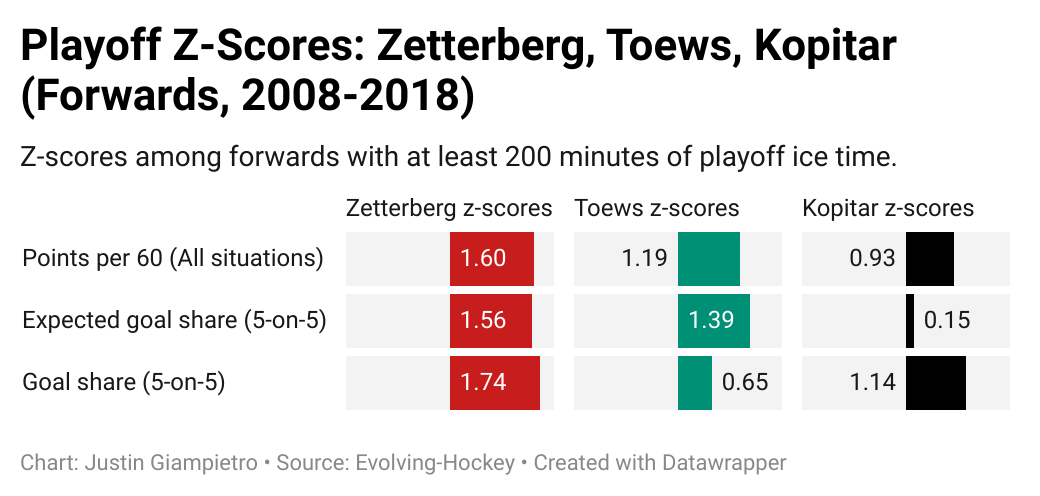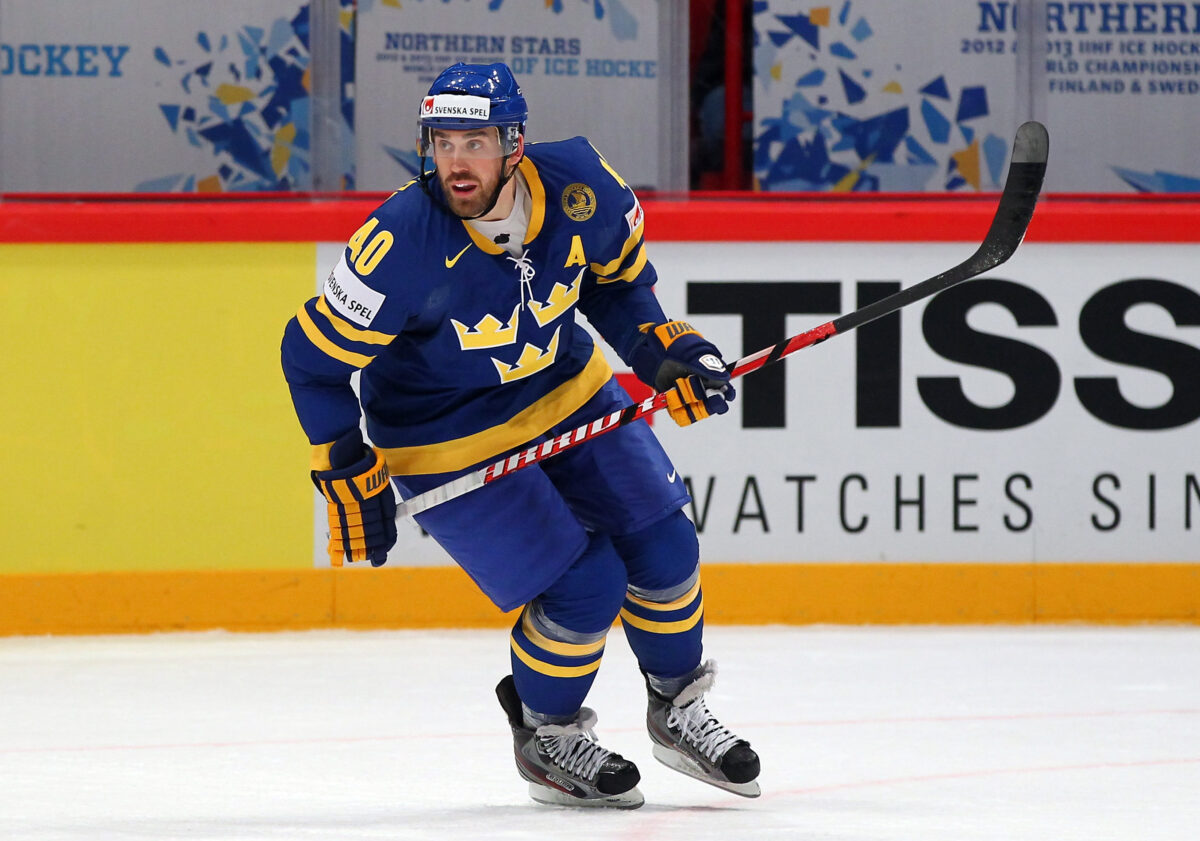It’s been seven seasons since Henrik Zetterberg last skated on NHL ice—he hasn’t played since 2017-18. The Detroit Red Wings legend has been gone for long enough now that he’s eligible for the Hockey Hall of Fame. But he hasn’t been inducted yet. Here are three reasons why he should be.
Reason One: Zetterberg’s Generational Two-Way Game
Zetterberg wasn’t just a great two-way forward. He defined an era. Not only was he able to drive play and put up points, but he was one of the best in his zone, too—that’s a rare breed of player.
Related: 3 Former Red Wings Deserving of Hall of Fame Induction
Between 2007-08 and 2014-15, Zetterberg found himself 13th in overall point-scoring. Among the top 13, he was the best at suppressing scoring chances at 5-on-5, in terms of expected goals against per 60 minutes. With a rate of 2.08, he was neck and neck with Anže Kopitar‘s 2.09.
I’ll focus on this point later, but it’s notable that Zetterberg ranged from 27 to 34 years old in that span. Though he should be commended for performing at such a high level for so long, it’s important to focus on his peak. Rather than cumulatively, what was his best single season?
From a two-way standpoint, that happened in 2007-08—he allowed 1.58 expected goals against per 60 minutes. Among each individual season of those 13 players as before, that’s 2.71 standard deviations above the mean. A statistical outlier.
It wasn’t just defense, either. Zetterberg’s 1.23 points per game that season (92 in 75) ranked 15th out of the 78 player seasons in the sample. Scoring at the rate of a superstar and giving up nothing the other way, he was basically perfect. You really can’t ask for better than that.
Getting away from the statistics, let’s just talk hockey. The on-ice stuff.
Zetterberg had an understanding of the game that not many players do. Starting defensively, his awareness, timing, positioning, and everything else were off the charts. That was probably best exemplified when he iconically defended a 5-on-3 penalty kill against a deadly Pittsburgh Penguins team in the 2008 Stanley Cup Final.
This is a player who knew where goals were scored. He knew when to be aggressive and when to stay back. He read the Penguins like a book on that aforementioned sequence. Still, Zetterberg was more than a “shut down your superstar” type of player. He was a “light up your goaltender” one, too. Zetterberg displayed the same level of cerebral ability on offense, making him one of the best in the NHL for a significant period of time.
Reason Two: Zetterberg’s Playoff and International Dominance
It wouldn’t be a Zetterberg piece if we didn’t focus on his play outside the NHL regular season. Starting with the playoffs, he took his game up a notch when he got there. He didn’t win the Stanley Cup and Conn Smythe Trophy in 2008 by accident.
To put his play in perspective, let’s look at his playoff z-scores in some key statistics: points per 60, expected goal share, and actual goal share. Compared to likely Hall-of-Fame two-way forwards Jonathan Toews and Anže Kopitar, Zetterberg bests them in every category:

The part I want to focus on here is Zetterberg’s goal share at 5-on-5, which is plus/minus as a percentage. It’s a metric that gets quite a bit of criticism, and deservedly so, in some instances. But potting two-thirds of all the goals you’re on the ice for (74 goals scored, 37 goals allowed) is championship stuff. That’s not normal for top-line players—you couldn’t contain Zetterberg once the postseason came around.
No matter the stage, no matter the magnitude of the moment, Zetterberg was there. I say that because he was just as good internationally.
You could argue that Zetterberg was a beneficiary of the Red Wings’ masterful team building, even if they wouldn’t have been nearly as successful without him. However, he was able to reach similar heights in a completely different environment: with Team Sweden.

In 2006, Zetterberg doubled up on gold. In the Olympics that winter, he put up six points en route to his golden prize. Later, in the World Championship, he put up five points for Sweden, helping them win yet another gold medal. He won silver at the 2014 Winter Olympics.
According to Elite Prospects, from the time Zetterberg played in his first World Championship game (2001) until his last (2012), he was tied for eighth in points with Alex Ovechkin and Rick Nash (44). While it was a lot of pre-prime Zetterberg playing internationally, he stood out all the same.
Reason Three: Zetterberg’s Longevity
Finally, we get to Zetterberg’s longevity. A receiver of Selke Trophy voting in his third NHL season as well as his 14th, the aging curve never quite hit him. He was almost always an elite talent.
Zetterberg’s peaks were quite impressive. Working against him is the fact that he never actually won a Selke Trophy (nominated once), nor did he win a regular-season award aside from the King Clancy Memorial Trophy in 2014-15. But his consistency helps to make up for that.
Between 2005-06 and 2017-18, spanning from his age-25 campaign through his age-37, he was ninth in total points with 873 in 942 games, according to QuantHockey. At 0.93 points per game, that rate exceeded Henrik Sedin, Daniel Sedin, and Marián Hossa—all of them are in the Hockey Hall of Fame. The Sedins each have an Art Ross Trophy to their name, but neither has a Stanley Cup. Hossa has three Stanley Cups, but no regular-season awards and no Conn Smythe Trophies. So, could you say that all four are equal?
In his career, Zetterberg put up 337 goals and 623 assists for 960 points and a plus-160 rating in 1,082 NHL contests. A first-line player essentially from start to finish, he was consistently atop his craft. Should he be in the Hockey Hall of Fame? Feel free to let us know your thoughts in the comments!
Stats courtesy of Evolving-Hockey (unless specified otherwise)
